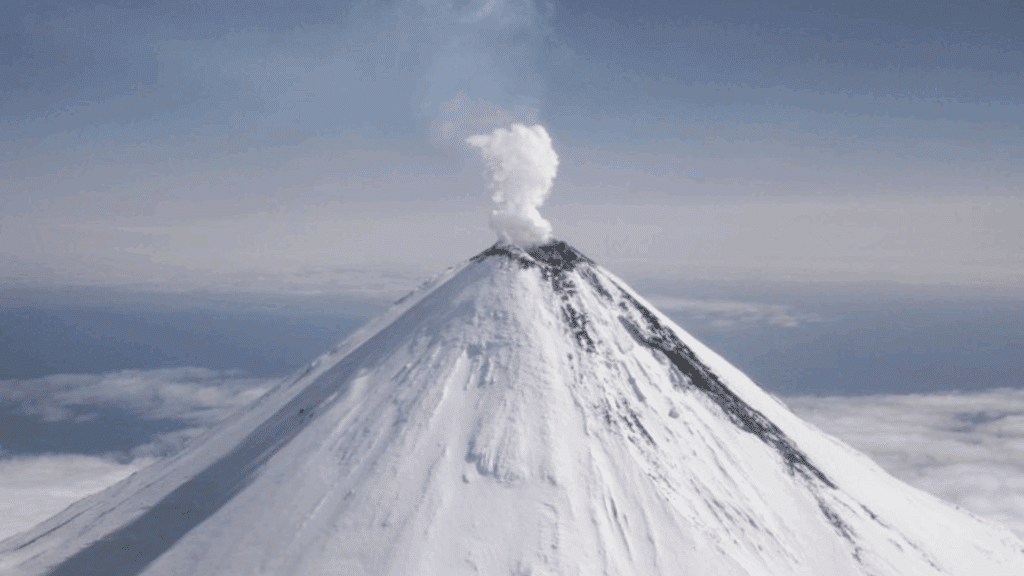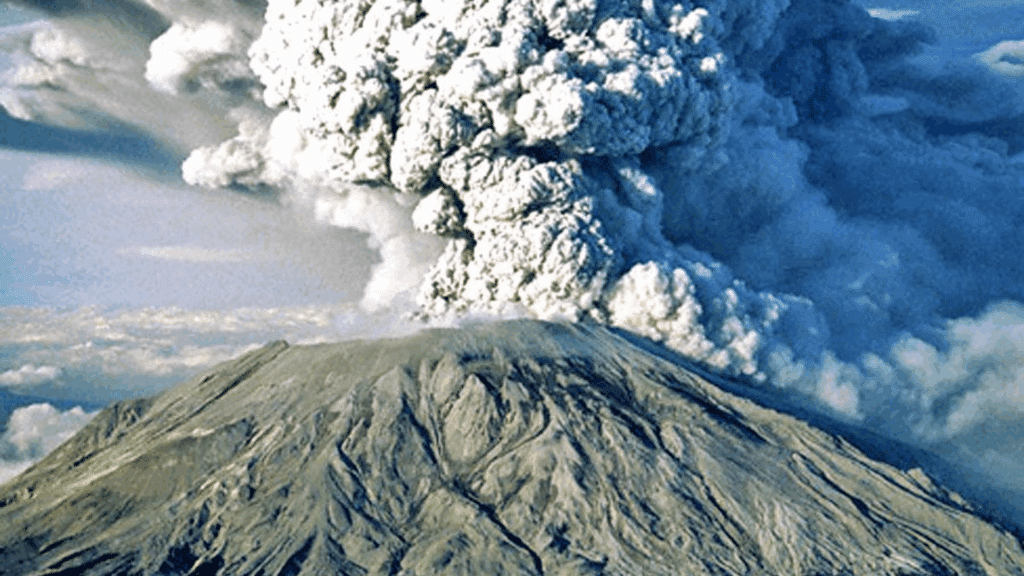Volcanoes can shoot lightning bolts during eruptions. Most people don’t know this wild fact about these fiery mountains.
Countless more secrets are hiding beneath the surface, from underwater volcanoes that build entire islands to ancient eruptions that completely changed civilizations.
These interesting facts about volcanoes will change how readers see these powerful geological forces and understand their actual impact on our world.
Understanding Volcanoes and Their Types
Volcanoes are openings in Earth’s surface where molten rock, gas, and ash escape from deep underground. These fiery mountains form when pressure builds up beneath the ground and finds a way out.
Here are the main types of volcanoes:
- Shield Volcanoes – Broad, gently sloping mountains built from fluid lava flows. Examples include Hawaii’s Mauna Loa and Kilauea. They have mild eruptions and cover large areas.
- Stratovolcanoes (Composite) – Tall, steep-sided cones made from alternating layers of lava and ash. Mount Fuji and Mount Vesuvius are examples. These produce explosive eruptions and are the classic volcano shape.
- Cinder Cone Volcanoes – Small, cone-shaped hills built from volcanic debris. They form quickly from single eruptions and are the simplest type. Paricutin in Mexico is a famous example.
- Supervolcanoes – Massive volcanic systems that can produce catastrophic eruptions. Yellowstone is the most well-known. They don’t form typical mountain peaks but create large calderas or depressions.
Fiery Volcano Interesting Facts

Volcanoes are Earth’s fiery storytellers, shaping landscapes, inspiring legends, and occasionally reminding us of their raw power.
Learn these interesting volcano fun facts :-
1. Volcanoes are openings in Earth’s crust
Volcanoes are natural vents in the Earth’s crust through which molten rock, gases, and ash can escape from deep underground.
These eruptions can build mountains, alter landscapes, and impact the environment globally. Volcanic eruptions contribute to the formation of new land, fertile soils, and even long-term climate changes.
2. The word ‘volcano’ comes from Vulcan
The term “volcano” comes from the name of Vulcan, the Roman god of fire.
The ancient Romans named the volcanic island Vulcano in the Mediterranean Sea after this deity, believing it was the chimney of Vulcan’s forge. The word later evolved to refer to all mountains that emitted fire and ash.
3. Over 1,500 active volcanoes exist on land today
An active volcano is one that has erupted during the Holocene epoch, which includes the past 10,000 years.
Over 1,500 such volcanoes are currently known on land, and many are continuously monitored for signs of future eruptions due to their proximity to human settlements and air traffic routes.
4. Most volcanoes are found along tectonic plate boundaries
Volcanoes tend to form where tectonic plates either collide, diverge, or slide past each other. These movements create fractures in the Earth’s crust, allowing magma to rise to the surface.
Subduction zones, mid-ocean ridges, and rift valleys are common sites of intense volcanic activity.
5. The ‘Ring of Fire’ holds about 75% of the world’s volcanoes
The Ring of Fire is a horseshoe-shaped zone encircling the Pacific Ocean known for its high seismic and volcanic activity.
This region contains roughly three-quarters of the world’s active and dormant volcanoes and is home to some of the most powerful eruptions and earthquakes ever recorded.
6. Underwater volcanoes are more common than land volcanoes
While land volcanoes are more visible and better known, most volcanic activity actually takes place beneath the oceans.
These submarine volcanoes form along mid-ocean ridges and seafloor spreading zones, contributing to the creation of new oceanic crust and underwater mountain ranges.
7. Magma is molten rock underground; it becomes lava when it erupts
Magma refers to molten rock stored beneath the Earth’s surface, often in magma chambers. When it breaks through the surface during an eruption, it is called lava.
Lava cools and solidifies to form new rock layers, while magma remains underground until an eruption occurs.
8. Volcanoes can be dormant, active, or extinct
Volcanoes are classified based on their eruption history. Active volcanoes have erupted recently or show signs of potential eruption.
Dormant volcanoes have not erupted for a long time but could again in the future. Extinct volcanoes have no magma supply and are unlikely to erupt again.
9. A volcano is considered active if it has erupted in the last 10,000 years
Geologists consider a volcano active if it has erupted during the Holocene epoch, which spans the last 10,000 years. This classification helps scientists prioritize which volcanoes to monitor closely for potential future eruptions and hazards.
10. Iceland has one of the highest concentrations of volcanoes
Iceland sits directly on the Mid-Atlantic Ridge, a tectonic plate boundary that produces frequent volcanic activity.
The country hosts over 130 volcanic mountains, including both active and dormant systems, and relies heavily on its geothermal energy derived from this activity.
11. Stratovolcanoes are tall and conical, e.g., Mount Fuji
Stratovolcanoes, or composite volcanoes, are built from alternating layers of lava, ash, and rock.
They have steep profiles and are capable of producing highly explosive eruptions, making them some of the most hazardous types of volcanoes on Earth.
12. Shield volcanoes are wide and flat, like Mauna Loa in Hawaii
Shield volcanoes have broad, gentle slopes and are built by the eruption of low-viscosity lava that flows over great distances. These volcanoes tend to erupt non-explosively and cover vast areas, making them some of the largest in terms of surface area.
13. Cinder cone volcanoes are the smallest and steepest
Cinder cones are formed from pyroclastic fragments like ash, lapilli, and volcanic bombs that fall close to the vent after being ejected. They are usually small in size, have steep sides, and often form on the flanks of larger volcanoes during short-lived eruptions.
14. Calderas are large volcanic craters formed by collapse
A caldera forms when a volcano’s magma chamber empties rapidly during an eruption, causing the ground above to collapse. These features can span several kilometers in diameter and often become lakes or host secondary eruptions over time.
15. Pyroclastic flows are deadly fast-moving currents of hot gas and rock
Pyroclastic flows are among the most lethal volcanic hazards, capable of racing down volcano slopes at over 100 kilometers per hour. These flows incinerate everything in their path due to their extreme temperature and speed, leaving widespread devastation.
16. Volcanic ash can travel thousands of kilometers
When volcanoes erupt explosively, they can eject fine ash particles high into the atmosphere.
Winds can carry this ash across continents, disrupting air travel, damaging engines, contaminating water supplies, and affecting human health and agriculture.
17. Some lava flows can move as fast as 60 km/h (37 mph)
Though many lava flows are slow, certain types of lava, such as basaltic lava on steep terrain, can travel at surprisingly high speeds.
These fast-moving flows can quickly destroy roads, homes, and forests, especially in the early stages of an eruption.
18. Supervolcanoes can eject over 1,000 cubic kilometers of material
Supervolcanoes represent the most massive and explosive volcanic events on Earth.
Their eruptions can eject vast amounts of ash and gas into the atmosphere, blocking sunlight and triggering global cooling that lasts for years or even decades.
19. Yellowstone is a supervolcano that hasn’t erupted in over 600,000 years
Yellowstone National Park sits atop a massive volcanic hotspot. Though it hasn’t erupted in over half a million years, ongoing geothermal activity and ground deformation indicate that the system remains active and is closely monitored by scientists.
20. Volcanic lightning can occur due to static electricity in ash clouds
During some explosive eruptions, ash particles collide and generate static charges, resulting in volcanic lightning. These dramatic displays of electricity in ash clouds add a dangerous and visually striking element to major eruptions.
21. Mauna Loa in Hawaii is the world’s largest volcano by volume
Mauna Loa is a massive shield volcano that covers over 5,000 square kilometers. It rises about 10 kilometers from the seafloor to its summit, making it the largest volcano on Earth by both area and volume.
22. Mount Everest is taller, but Mauna Kea is the tallest from base to summit
Mauna Kea, also in Hawaii, measures over 10,000 meters from its base on the ocean floor to its summit, surpassing Mount Everest when measured this way. Most of its bulk is hidden beneath the ocean surface.
23. Mount Etna in Italy is the most active volcano in Europe
Mount Etna has been erupting for thousands of years and is currently one of the most active volcanoes in the world. Its frequent eruptions have shaped Sicily’s landscape and economy, and it remains a focus of scientific study.
24. Mount Vesuvius buried Pompeii in 79 AD and is still considered active
The catastrophic eruption of Mount Vesuvius preserved the Roman cities of Pompeii and Herculaneum under ash. Despite long periods of dormancy, Vesuvius is still active and poses a serious risk to the densely populated Naples area.
25. Indonesia has the most active volcanoes of any country
Located along multiple tectonic boundaries, Indonesia has around 130 active volcanoes. The country experiences frequent eruptions and is home to some of the most dangerous volcanoes on Earth, including Krakatoa and Merapi.
26. The Krakatoa eruption in 1883 was heard 3,000 miles away
Krakatoa’s cataclysmic eruption in Indonesia produced one of the loudest sounds ever recorded in human history. The explosion was heard as far away as Australia and the island of Rodrigues near Africa. The eruption generated massive tsunamis, killed over 36,000 people, and had significant global atmospheric effects.
27. The Tambora eruption in 1815 caused the “Year Without a Summer”
Mount Tambora’s eruption in Indonesia was the largest in recorded history, ejecting vast amounts of ash and sulfur into the atmosphere.
This led to a dramatic drop in global temperatures, failed harvests, and widespread famine across the Northern Hemisphere in 1816, which became known as the “Year Without a Summer.”
28. The Parícutin volcano in Mexico was born in a farmer’s cornfield in 1943
One of the rare cases of humans witnessing the birth of a volcano, Parícutin emerged suddenly in a cornfield and erupted continuously for nine years.
The event allowed scientists to observe the full life cycle of a volcano from formation to dormancy, making it a geological landmark.
29. Mount St. Helens erupted in 1980, the deadliest in U.S. history
The 1980 eruption of Mount St. Helens in Washington State was preceded by earthquakes and a massive landslide, the largest in recorded history. The eruption killed 57 people, destroyed 250 homes, and altered the mountain’s shape by removing its summit and creating a large crater.
30. Eyjafjallajökull in Iceland disrupted air travel across Europe in 2010
Eyjafjallajökull erupted beneath a glacier, sending a massive plume of ash into the atmosphere.
The fine ash cloud grounded more than 100,000 flights and affected millions of travelers across Europe, highlighting how even moderate eruptions can severely impact global transportation.
31. Volcanic soil is extremely fertile, great for agriculture
Ash and lava break down into nutrient-rich minerals that enrich the soil, making regions near volcanoes some of the most productive for farming.
Countries like Indonesia, Italy, and the Philippines benefit from this fertility despite the volcanic risk.
32. Volcanoes help release Earth’s internal heat
Volcanoes are part of Earth’s heat-regulating system, venting internal energy and material from the mantle to the crust. This release helps maintain geological balance and supports geothermal activity, which powers everything from geysers to hydrothermal vents.
33. Volcanic rocks are used in construction and industry
Materials like pumice, basalt, and obsidian are products of volcanic activity and have various commercial uses. Pumice is used in abrasives and cosmetics, basalt in road construction, and obsidian historically for tools and decorative objects.
34. Volcanic ash can damage jet engines and ground flights
Ash particles can melt inside jet engines, leading to sudden failure.
This risk has caused aviation authorities to monitor volcanoes closely and establish no-fly zones when eruptions send ash into commercial air routes.
35. Volcanic gases include carbon dioxide, sulfur dioxide, and water vapor
Gases released during eruptions can be hazardous to health and the environment.
Sulfur dioxide can lead to acid rain, while carbon dioxide in high concentrations can be lethal, especially when it accumulates in low-lying areas.
36. Some volcanic lakes are highly acidic, like Lake Nyos
Volcanic crater lakes can accumulate dissolved gases like carbon dioxide and sulfur compounds. Lake Nyos in Cameroon suddenly released a large cloud of CO₂ in 1986, suffocating over 1,700 people and countless animals in nearby villages.
37. Volcanoes can create new islands, like Surtsey in 1963
The island of Surtsey formed off the coast of Iceland during an undersea eruption. It provided scientists with a rare opportunity to study how life colonizes new land, from bacteria to plants and birds, in a pristine environment.
38. Geothermal energy can be harnessed from volcanic heat
Countries like Iceland, the Philippines, and New Zealand use volcanic heat to generate electricity and provide heating. This renewable energy source is environmentally friendly and sustainable, making it a growing part of green energy strategies.
39. Volcanic eruptions can affect climate by blocking sunlight
Ash and sulfur dioxide released into the atmosphere can form aerosols that reflect sunlight, leading to temporary global cooling.
Historic eruptions like Tambora and Pinatubo had measurable impacts on global temperatures for several years.
40. The global temperature dropped by about 0.5°C after the Tambora eruption
Tambora’s 1815 eruption caused a major climate anomaly due to sulfur aerosols in the stratosphere.
The resulting temperature drop led to crop failures, food shortages, and extreme weather across the globe, especially in Europe and North America.
41. Ancient cultures often viewed volcanoes as homes of gods or spirits
Civilizations around the world interpreted volcanic eruptions as divine acts.
From the Greeks and Romans to Hawaiians and Aztecs, volcanoes were often revered, feared, and incorporated into religious beliefs and rituals.
42. The eruption of Vesuvius preserved Pompeii in volcanic ash
In 79 AD, Vesuvius buried the Roman city of Pompeii in ash and pumice, freezing it in time.
The remarkably preserved ruins provide a rare and detailed glimpse into Roman daily life, architecture, and art nearly 2,000 years ago.
43. The Aztecs believed volcanic eruptions were signs from the gods
Aztec mythology linked volcanoes to deities like Xiuhtecuhtli, the fire god. Eruptions were seen as expressions of divine anger or messages from the underworld, and sacrifices were sometimes made to appease these forces.
44. Many indigenous Hawaiian legends describe Pele, the volcano goddess
Pele is believed to live in the Halemaʻumaʻu crater at Kīlauea. She is both a creator and destroyer, symbolizing the dual nature of volcanic activity.
Hawaiian oral traditions and cultural practices remain closely tied to volcanic landscapes.
45. Romans sacrificed animals to appease Vulcan during eruptions
The Roman festival Vulcanalia, held on August 23, honored Vulcan with sacrifices and offerings to prevent fires and eruptions.
These rituals reflected the deep fear and respect ancient societies had for volcanic power.
46. The word “lava” comes from the Italian word for “to wash”
The term “lava” was first used in 1737 to describe the liquid rock flowing from Vesuvius. It comes from the Latin word “lavare,” meaning “to wash,” as lava was compared to a stream of water washing down a slope.
47. Pliny the Younger documented Vesuvius’ eruption in detailed letters
His eyewitness account of the 79 AD eruption provides one of the earliest detailed records of a volcanic disaster. Written in letters to the Roman historian Tacitus, Pliny’s observations have been invaluable to volcanology.
48. Some volcanoes have been used as prisons or places of exile
Due to their isolation and difficult terrain, volcano islands like Devil’s Island and volcanic calderas have historically served as natural prisons or places to banish criminals and political dissidents.
49. Volcanic eruptions have been blamed for the fall of civilizations
Eruptions have triggered famine, migration, and collapse in ancient societies. The Minoan civilization may have been devastated by the eruption of Thera (Santorini), and other cultures have been similarly affected by volcanic disasters.
50. Volcanic activity might have inspired ancient myths of dragons
Explosions, fire, and smoke from volcanoes may have inspired myths about fire-breathing creatures. Stories of dragons, serpents, and fire gods often originated near volcanically active regions, blending natural observation with folklore.
51. The largest eruption in the last 2 million years was Toba in Indonesia
The Toba supereruption occurred about 74,000 years ago on Sumatra and is considered the most powerful eruption in the Quaternary period.
It released an estimated 2,800 cubic kilometers of volcanic material and may have triggered a volcanic winter that caused a global human population bottleneck.
52. Volcanic eruptions can trigger earthquakes and tsunamis
When magma moves underground, it can fracture rock and cause earthquakes. Explosive eruptions near or under the ocean can displace large volumes of water, leading to tsunamis that travel across oceans at high speed, causing widespread devastation.
53. Lava tubes are tunnels formed by flowing lava beneath the surface
Lava tubes develop when the surface of a lava flow cools and solidifies while molten lava continues to flow underneath. Once the lava drains out, a hollow tunnel remains.
These structures can stretch for miles and are often explored by scientists and spelunkers.
54. The deadliest volcanic eruption was Tambora in 1815 with around 100,000 deaths
Mount Tambora’s eruption directly and indirectly killed approximately 100,000 people, mostly from starvation due to crop failures.
The ash and gases it released caused widespread climatic anomalies, famine, and disease across much of the globe.
55. Lake Nyos released a lethal cloud of CO₂ in 1986, killing over 1,700 people
In Cameroon, a sudden limnic eruption at Lake Nyos caused CO₂ to escape in a dense cloud that flowed into surrounding valleys. The odorless, colorless gas suffocated people and animals, highlighting the danger of gas accumulation in crater lakes.
56. Volcanoes exist on other planets and moons, e.g., Olympus Mons on Mars
Olympus Mons is the tallest known volcano in the solar system, rising about 22 kilometers high on Mars.
Volcanic activity has also been detected on Venus, Io (a moon of Jupiter), and Enceladus (a moon of Saturn), suggesting planetary volcanism is widespread.
57. Olympus Mons is the tallest volcano in the solar system
Located on Mars, Olympus Mons is roughly three times the height of Mount Everest.
It spans over 600 kilometers in diameter and formed due to the lack of tectonic plate movement on Mars, allowing lava to accumulate in one place for millions of years.
58. Some eruptions can last for decades, like Mount Yasur in Vanuatu
Mount Yasur has been erupting continuously for over 800 years, with frequent Strombolian-style eruptions. This makes it one of the most accessible and continuously active volcanoes in the world, drawing scientists and tourists alike.
59. Lava is hotter than most flames, reaching up to 1,200°C (2,200°F)
The temperature of erupting lava varies based on its composition, but it generally ranges between 700°C and 1,200°C. Such extreme heat is capable of instantly igniting materials and melting through metal and rock.
60. The smell of sulfur (“rotten eggs”) comes from hydrogen sulfide gas
During eruptions, volcanoes release hydrogen sulfide (H₂S), which has a strong rotten egg odor. In high concentrations, this gas can be toxic or even lethal, making it an important hazard to monitor during eruptions.
61. People roast marshmallows over lava (not recommended!)
Though it has been attempted as a novelty, roasting marshmallows over lava is extremely dangerous due to toxic gases and extreme temperatures.
Experts strongly discourage such stunts, as exposure to volcanic gases can cause severe health issues.
62. There are volcano-sniffing drones used to collect data
Modern volcano monitoring includes drones equipped with sensors to measure gas emissions and temperature. These drones allow scientists to collect real-time data from hazardous or inaccessible volcanic areas without endangering human lives.
63. Some volcanoes create lava domes instead of cones
Lava domes form when thick, viscous lava oozes slowly out of a volcano and piles up near the vent. These domes can grow gradually over months or years and may collapse or explode violently if pressure builds beneath them.
64. Volcanic ash has been used in cosmetics and soap
Finely ground volcanic ash is rich in minerals and mildly abrasive, making it a popular ingredient in exfoliating skin products and natural soaps. It’s also used in face masks for its supposed detoxifying properties.
65. The sound of a large eruption can circle the globe multiple times
Major eruptions, like Krakatoa in 1883, produced pressure waves that were detected circling the planet multiple times.
These low-frequency sounds, called infrasound, can travel vast distances and are used today to detect remote volcanic events.
66. Volcanic tuff is used in sculpture and building
Tuff is a soft, porous rock made from compacted volcanic ash. It has been used historically in construction and sculpture due to its ease of carving and insulating properties.
Structures made from tuff are found in Italy, Turkey, and parts of the Americas.
67. Entire towns have been relocated due to volcanic threats
Communities near active volcanoes have sometimes been evacuated or moved permanently to safer areas.
Examples include towns near Mount Pinatubo in the Philippines and the relocation of Rabaul in Papua New Guinea after repeated eruptions.
68. Volcanic eruptions inspired art and literature, including “Dark Romanticism”
The power and unpredictability of volcanoes have influenced writers, poets, and painters.
The dramatic skies painted by J.M.W. Turner after Tambora’s eruption and Mary Shelley’s “Frankenstein,” written during the Year Without a Summer, reflect this influence.
69. Some volcanic craters are filled with crystal-clear blue lakes, making them tourist hotspots
Many dormant or extinct volcanoes have calderas that now host beautiful crater lakes. Examples include Crater Lake in Oregon, Lake Toba in Indonesia, and Quilotoa in Ecuador.
These sites attract visitors with their vivid colors and serene landscapes, though they remain closely watched for any signs of renewed activity.
Can We Predict When a Volcano Is Going to Erupt?

Scientists can’t predict exact eruption times, but they watch for warning signs that suggest a volcano might erupt soon. These signals help communities prepare and evacuate if needed.
Modern monitoring equipment tracks changes that happen weeks or months before eruptions.
- Increased Earthquakes: Small tremors increase as magma moves underground. Scientists use seismometers to detect these quakes that people often can’t feel.
- Ground Swelling: The volcano’s surface bulges outward as magma pushes up from below. GPS and satellite measurements track these changes.
- Gas Changes: Volcanoes release more sulfur dioxide and other gases before eruptions. Scientists test air samples to monitor gas levels.
- Rising Temperatures: Hot springs and ground temperatures increase around the volcano. Thermal cameras help detect heat changes.
- Water Changes: Nearby springs may dry up, change temperature, or become more acidic as underground conditions shift.
- Animal Behavior: Local animals sometimes act strangely before eruptions, though this isn’t always reliable for predictions.
Conclusion
These interesting facts about volcanoes show how these fiery giants continue shaping our planet every day. From creating new islands to changing weather patterns, volcanoes have built the world we know today.
Understanding how they work helps protect communities living near active ones.
Future generations will face volcanic activity just like we do now. Teaching them about volcanic warning signs, eruption types, and safety measures could save lives.
Scientists keep learning more about these powerful forces, but there’s still much to study. Volcanoes remind us that Earth is alive and constantly changing beneath our feet.


















